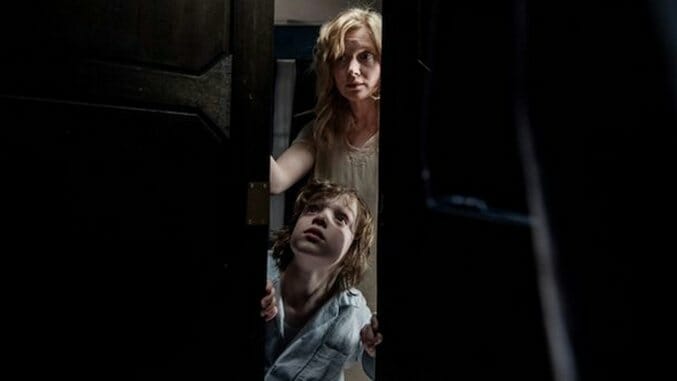You Can’t Get Rid of the Babadook…
An Australian indie horror film showcases the monster our kids bring out in us

Note: This article features significant ending spoilers for a must-watch film that is only a couple of years old, right as we head into scary movie season.
Your mother’s done it, too (or you’ve done it, if you’ve been a mother yourself for long enough): One day, when you did something you didn’t realize was wrong, the warm, pretty creature who feeds you suddenly snapped and became a heedless, screaming beast.
There are a hundred little technical reasons Australian director Jennifer Kent’s 2014 film The Babadook is a damn fine horror movie, and one of the scariest features I’ve seen in many a long year. But I suspect the reason a veteran like William Friedkin tweeted that he had “never seen a more terrifying film,” or that it continues to persist in my own Netflix rotation, is that it traffics in some of the most primal fears we experience now that we’ve tamed the wilderness that once threatened the family unit and are left cooped up in our nice houses, with only one another for company.
“Don’t let it in!” the child begs throughout the movie. It’s only at the end that he discovers, as do we, the monster that stalks the characters in The Babadook was there all along, and ever shall be.
Adapted from Kent’s 2005 short film “Monster,” her feature-length debut, for which she also wrote the screenplay, follows widow Amelia (Essie Davis) and her grade school son Samuel (Noah Wiseman) as they cope with life in a fatherless household in Southern Australia. Samuel’s special needs, fits of paranoia and predilection for curiously well-engineered projectile weapons are driving Amelia to her wit’s end. She feels stifled at work, isolated from her family and friends by the depression she struggles with, and unable even to get her rocks off in bed alone without Samuel pestering her for motherly affection. Beneath it all is the constant reminder that Amelia’s husband died in a car crash en route to the hospital the day she gave birth to Samuel, in case there was any doubt that childbirth can strain or even destroy a marriage.
It’s a credit to Wiseman and the script that the audience sympathizes with the poor kid rather than view him as an annoying little flibbertigibbet who excites enmity in everyone around him. Anybody with a family member with special needs—or indeed, any parent with a kid prone to blurting out whatever comes to mind in the moment—understands both Samuel’s innocent, earnest love for his mother and Amelia’s feelings of suffocation at being his sole caregiver, her travails at home mirrored in her job at a senior living facility where she calls out bingo numbers to people too senile to play.
Samuel’s inability to get along with other children, and Amelia’s lashing out at well-meaning if oblivious friends, drive them into isolation. And one night, with Samuel home from school after nearly hurting another kid, Amelia lets him select a book to read just to shut him up. He picks one she’s never seen before, though it came from her own shelf in her own house. It’s called Mr. Babadook, and weird things start happening after she reads it to him.
Anybody who’s been raised by one parent—an increasingly common occurrence—knows the feelings Amelia struggles with. I work in a state legislature, and while I know things are different in Australia, I can tell you that there is no political liability in openly scorning single motherhood. Society treats families like Amelia’s as utterly undeserving of help. Tired and stressed and unable to pay the bills? Well, get a man. Need time to go fishing for a husband? You’re an awful mother for wanting to do that instead of controlling your child, and you should feel bad he doesn’t fit into the little box we’ve marked out for him. How dare your asshole kid be an asshole to the hundreds of other asshole kids who fight at ice cream parlors, taunt unpopular children, and whine about their birthday presents (as the kids in this film all do)?
-

-

-

-

-

-

-

-

-

-

-

-

-

-

-

-

-

-

-

-

-

-

-

-

-

-

-

-

-

-

-

-

-

-

-

-

-

-

-

-








































